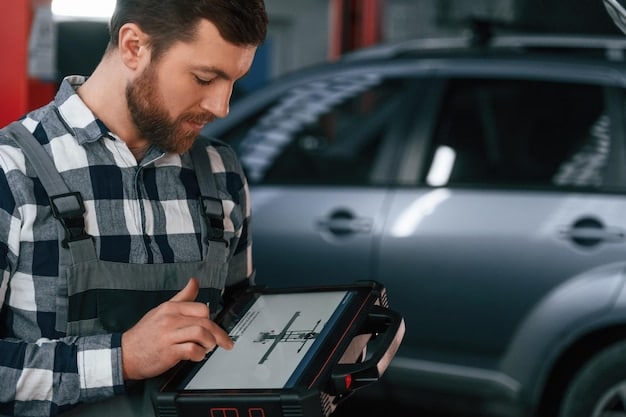The Ultimate Car Buying Checklist 2025: Avoid Costly Mistakes

Buying a car in 2025 requires navigating new technologies and market trends; this checklist helps you avoid common pitfalls, secure the best deal, and ensure a smooth purchase process.
Navigating the car market in 2025 can feel like a maze, with evolving technologies and economic factors adding layers of complexity. This comprehensive guide, the ultimate car buying checklist for 2025: avoid these common mistakes, equips you with the knowledge to make informed decisions and drive away with confidence.
Set Your Budget and Stick to It
Before you even start browsing models, defining your budget is crucial. This isn’t just about the sticker price; it’s about understanding the total cost of ownership.
Consider All Costs
Factor in expenses beyond the car’s price, such as registration fees, insurance premiums, and potential maintenance costs. Research average insurance rates for different models to avoid surprises.
Pre-Approval for Financing
Getting pre-approved for a car loan gives you a clear understanding of how much you can borrow and at what interest rate. This strengthens your negotiating position at the dealership.
- Estimate monthly payment, ensuring affordability.
- Shop around for the best interest rates.
- Factor in down payment when calculating loan amount.
Sticking to your budget prevents overspending and ensures you can comfortably manage the financial commitment of owning a car. Remember, a lower price doesn’t always equate to the best value long-term.

Research Car Models and Features
Don’t walk into a dealership without doing your homework. Researching car models and features allows you to narrow down your options and identify vehicles that best suit your needs.
Identify Needs and Priorities
Consider your daily driving habits, family size, and lifestyle. Do you prioritize fuel efficiency, cargo space, or advanced safety features?
Read Reviews and Comparisons
Consult reputable sources like automotive magazines and websites for in-depth reviews and comparisons of different models. Pay attention to both expert opinions and owner feedback.
- Compare safety ratings from IIHS and NHTSA.
- Analyze fuel economy and reliability data.
- Consider long-term cost of ownership for each model.
Thorough research ensures you choose a car that meets your practical needs and aligns with your personal preferences. Don’t get swayed by shiny features alone; focus on what truly matters to you.
Secure Financing Before Visiting a Dealer
Obtaining pre-approved financing is a strategic move that puts you in a stronger negotiating position when you visit the dealership. It also helps you avoid potential pitfalls in the dealer’s financing department.
Compare Loan Offers
Shop around for the best interest rates and loan terms from banks, credit unions, and online lenders. Comparing offers ensures you get the most favorable financing deal.
Understand Loan Terms
Carefully review the fine print of any loan agreement, paying attention to interest rates, loan duration, and potential fees. Don’t hesitate to ask questions about anything you don’t understand.
Entering the dealership with pre-approved financing empowers you to focus on negotiating the car’s price, rather than getting caught up in the complexities of financing. It also prevents the dealer from inflating interest rates or adding unwanted extras.
Carefully Inspect the Vehicle
Whether buying new or used, a thorough vehicle inspection is essential. Overlooking potential issues can lead to costly repairs down the road.
Exterior Inspection
Check for dents, scratches, rust, and mismatched paint. Pay attention to panel alignment and any signs of previous accident damage.
Interior Inspection
Examine the seats, carpeting, dashboard, and all interior features. Test the air conditioning, heating, and all electronic components.

- Inspect tires for wear and tear.
- Check fluid levels (oil, coolant, brake fluid).
- Examine belts and hoses for cracks or leaks.
A comprehensive inspection helps you identify potential problems before committing to the purchase. If you’re not mechanically inclined, consider hiring a qualified mechanic to perform a pre-purchase inspection.
Take a Comprehensive Test Drive
A test drive is your opportunity to assess the car’s performance and handling in real-world conditions. Don’t just drive around the block; take it on a variety of roads.
Evaluate Performance
Test the car’s acceleration, braking, and handling on different surfaces. Pay attention to engine noise, transmission smoothness, and overall responsiveness.
Check Comfort and Ergonomics
Assess the comfort of the seats, the visibility from the driver’s seat, and the ease of use of all controls. Ensure the car is a good fit for your body type and driving style.
A complete test drive allows you to experience all aspects of the car before making a decision. Pay attention to any unusual noises, vibrations, or handling quirks that could indicate underlying issues.
Negotiate the Price Effectively
Negotiating the price is a critical part of the car-buying process. Don’t be afraid to negotiate aggressively to get the best possible deal.
Research Market Value
Use online resources to determine the fair market value of the car you’re interested in. Knowing the average price will help you negotiate effectively.
Be Prepared to Walk Away
Dealerships are more likely to negotiate with buyers who are willing to walk away from the deal. Don’t be afraid to say “no” if the price isn’t right.
- Negotiate the final price, not the monthly payment.
- Don’t reveal your maximum budget upfront.
- Be polite but firm throughout the process.
Successful negotiation requires research, preparation, and a willingness to walk away. Remember, the goal is to get a fair price that benefits both you and the dealership.
| Key Point | Brief Description |
|---|---|
| 💰 Budgeting | Set a realistic budget considering all ownership costs. |
| 🔍 Research | Thoroughly research models, features, and safety ratings. |
| 🏦 Financing | Secure pre-approved financing before visiting the dealer. |
| 🚗 Inspection | Carefully inspect the vehicle before committing to purchase. |
Frequently Asked Questions
▼
A good down payment depends on the car’s price and your financial situation. Aim for at least 10% of the vehicle’s cost to lower monthly payments and interest charges.
▼
Research the car’s market value, compare prices at different dealerships, and be prepared to walk away if the dealer doesn’t meet your price range.
▼
Pay attention to the car’s acceleration, braking, handling, and overall comfort. Test it on different road conditions and listen for any unusual noises.
▼
The best option depends on your needs and preferences. Buying is better long-term, while leasing offers lower monthly payments and the ability to upgrade more frequently.
▼
Follow the manufacturer’s recommended service schedule, typically every 7,500 to 10,000 miles, to maintain its performance and avoid potential warranty issues.
Conclusion
By following this checklist diligently, you can boost the chances of making a well-informed car purchase. With research, careful planning, and savvy negotiation, you’ll be ready to drive away with a car that meets your needs and fits your budget.





